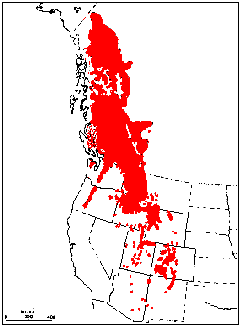
Drawing of the largest known subalpine fir, at Cream Lake [Robert Van Pelt] (1).

Seed cone [L.A. Vorobik] (10).

The range of
A. lasiocarpa
combined with that of
A. bifolia
(2).
Common Names
Subalpine fir, alpine fir, balsam fir, white fir, mountain balsam fir (3), sapin concolore (6).Taxonomic notes
Syn: Pinus lasiocarpa Hooker 1838. See also Abies bifolia , which includes most of the populations formerly described as A. lasiocarpa (6).A. lasiocarpa formerly included the Rocky Mountain populations now segregated as A. bifolia . Also see A. bifolia for remarks on the variety, arizonica .
Through central British Columbia and northern Washington, Abies lasiocarpa introgresses with A.bifolia . These trees may have morphologic features resembling either species and may have intermediate terpene patterns; they are best classified as interior subalpine fir ( A. bifolia × lasiocarpa ). At the southern end of its range, A. lasiocarpa possibly hybridizes with A.procera (Hunt and von Rudloff 1979). Abies lasiocarpa shares with A.procera a red periderm, crystals in the ray parenchyma (Kennedy et al. 1968), and reflexed tips of the bracts, features not shared with A.bifolia (6).
The only unique populations in this species come from coastal Alaska (7, 8). They are found at lower elevations (0-900 m) and appear to be isolated with no reported introgression between them and the coastal mountain populations. The population on the Prince of Wales Island has distinct terpene patterns and needs morphological and developmental studies to see if these patterns contrast with neighboring populations (6).
Description
"Trees to 20 m; trunk to 80 cm diam.; crown spirelike. Bark gray, thin, smooth, furrowed in age. Branches stiff, straight; twigs opposite to whorled, greenish gray to light brown, bark splitting as early as 2 years to reveal red-brown layer, somewhat pubescent; fresh leaf scars with red periderm. Buds hidden by leaves or exposed, tan to dark brown, nearly globose, small, resinous, apex rounded; basal scales short, broad, equilaterally triangular, glabrous or with a few trichomes at base, not resinous, margins crenate to dentate, apex sharp-pointed. Leaves 1.8-3.1 cm × 1.5-2 mm, spiraled, turned upward, flexible; cross section flat, prominently grooved adaxially; odor sharp (ß-phellandrene); abaxial surface with 4-5 stomatal rows on each side of midrib; adaxial surface bluish green, very glaucous, with 4-6 stomatal rows at midleaf, rows usually continuous to leaf base; apex prominently or weakly notched to rounded; resin canals large, ± median, away from margins and midway between abaxial and adaxial epidermal layers. Pollen cones at pollination ± purple to purplish green. Seed cones cylindric, 6-12 × 2-4 cm, dark purple, sessile, apex rounded; scales ca. 1.5 × 1.7 cm, densely pubescent; bracts included (specimens with exserted, reflexed bracts are insect infested). Seeds 6 × 2 mm, body brown; wing about 1.5 times as long as body, light brown; cotyledons 4-5. 2 n =24" (6).Range
Canada: S Yukon and the Coast Range of British Columbia. USA: Coast ranges of SE Alaska, the Olympics of Washington, the Cascades of Washington and Oregon, and the Trinity Mountains of California. Typically found at 1100-2300 m elevation in coastal subalpine conifer forests (3). It is found growing to the alpine treeline in most of its range (4). Common associates include Abies amabilis , Pinus albicaulis and Tsuga mertensiana . See also (11).Big Tree
Largest: Diameter 204 cm, height 38.1 m, crown spread 8 m in 1992, at Cream Lake in Olympic National Park, WA (1).Tallest: Diameter 107 cm, height 52 m, crown spread 7 m in 1988; on the Icicle Creek Trail in the Alpine Lakes Wilderness of WA (1).
Oldest
In 1986, sampled some trees over 400 years old (ring count) in Olympic National Park, WA.Dendrochronology
Ethnobotany
Observations
Very common in the subalpine zone of mountains throughout its range. It occurrences in Olympic and Mount Rainier National Parks are particularly noteworthy, having been the subject of a numerous ecological studies of the trees' population dynamics, response to fire, habitat value, etc. (see notes and citations in (9)).Remarks
"Abies lasiocarpa usually exists in small stands at high elevations and is not often observed. Its differences in comparison to A.bifolia have prompted studies (Parker et al. 1979) to see if it is A.bifolia introgressed with the sympatric A. amabilis. Abies lasiocarpa and A.amabilis , however, are separated by many morphologic features, and no hybrids have been found (Parker et al. 1979)" (6).Citations
(1) Van Pelt 1996 .(2) Fowells 1965 .
(3) Peattie 1950 .
(4) Little 1980 .
(5) American Forests 1996 .
(6) Richard S. Hunt at the Flora of North America web site .
(7) Harris, A.S. 1965. Subalpine fir [ Abies lasiocarpa (Hook.) Nutt.] on Harris Ridge near Hollis, Prince of Wales Island, Alaska. Northwest Science 39:123-128.
(8) Heusser, C.J. 1954. Alpine fir at Taku glacier, Alaska, with notes on its post glacial migration to the territory. Bulletin of the Torrey Botanical Club 81:83-86.
(9) Arno, Stephen F. and Ramona Hammerly. 1984. Timberline: mountain and arctic forest frontiers. Seattle: The Mountaineers.
(10) Hickman 1993 .
(11) Robert S. Thompson, Katherine H. Anderson and Patrick J. Bartlein. 1999. Atlas of Relations Between Climatic Parameters and Distributions of Important Trees and Shrubs in North America. U.S. Geological Survey Professional Paper 1650 A&B. URL= http://greenwood.cr.usgs.gov/pub/ppapers/p1650-a/pages/conifers.html , accessed 22-Jan-2000.
See also:
Burns & Honkala 1990
.
Lanner 1983
.
Liu 1971
(5 pages).
MacKinnon et al. 1992
.
FEIS database
.
Vidakovic 1991
.
Zavarin, E., K.Snajberk, T.Reichert, and Tsien E. 1970. On the geographic variability of the monoterpenes from the cortical blister oleoresin of Abies lasiocarpa. Phytochemistry 9:377-395.
[ Abies ] [ Pinaceae ] [ home ]
This page is from the Gymnosperm Database
URL: http://www.geocities.com/RainForest/Canopy/2285/pi/ab/lasiocarpa.htm
Edited by Christopher J. Earle
E-mail:
earlecj@earthlink.com
Last modified on 22-Jan-2000